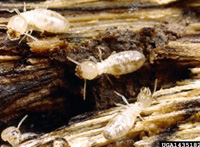Termites repelled by catnip oil

Caption: Subterranean termite workers (Reticulitermes sp.)
Known for its intoxicating effects on felines, catnip oil may also have a future in termite control. Recent experiments by USDA Forest Service researcher Chris Peterson show that catnip oil repels and even kills termites in a laboratory setting.
Peterson, a researcher with the Forest Service Southern Research Station (SRS), and fellow researcher Janice Ems-Wilson, a chemist at Valencia Community College in Orlando, FL, presented the results of their research at the national meeting of the American Chemical Society held March 23 – 27 in New Orleans.
An entomologist with the SRS Wood Products Insect Research unit in Starkville, MS, Peterson has been testing essential catnip oil as a possible replacement for the more toxic pesticides presently used to control termites. Probably the most common termite control method is treating the soil next to wood structures with chemical compounds: some of the active ingredients of traditional termiticides, such as chlordane and chlorpyrifos, have lost their registrations in the U.S. due to their toxicity. New, more eco-friendly compounds are being sought to fill the void.
The search for new termiticidal products is active. “The USDA Forest Service routinely tests about three new termite formulations for effectiveness every year, with a new active ingredient tested about once in every two years,” said Peterson. “Natural compounds from plants, bacteria, and fungi could provide new commercial products that are less toxic to humans and the environment.”
For their termite study, Peterson and Ems-Wilson infused sand with catnip essential oil–the kind routinely sold in pet stores–to test the effectiveness of the oil as a barrier to termite tunneling. To test vertical tunneling, the researchers placed yellow pine sapwood in the bottom of a test tube filled with sand. A two-inch barrier of catnip-treated sand separated the termites in the top layer of untreated sand from the pine. To test horizontal tunneling, the researchers constructed a barrier of treated sand across the middle of a transparent box of sand, again with the tempting pine placed across the barrier from the termites. In both tests, catnip oil reduced or eliminated termite tunneling.
Peterson and Ems-Wilson also tested the catnip oil for its toxicity to termites by treating them directly with a dilution of the oil, fumigating them, and exposing them to catnip-infused soil. The researchers carefully counted the termites in the multiple tests on barriers to make sure the barrier-effect they found was not due to termite mortality.
“At higher concentrations, the oil does kill termites, but not as effectively as the commercial compounds currently used in soil treatments,” said Peterson. “Our results show that catnip oil is a very effective deterrent to termite tunneling, with the effective doses tested much lower than those reported for similar natural products.”
Unfortunately, catnip oil breaks down quickly in the environment. The chemicals now used to prevent termite infestation must remain effective for more than five years in government testing. “There is the inevitable tradeoff,” said Peterson. “Chemicals that last a long time also have greater potential for environmental damage. We hope that the active ingredients in catnip oil can eventually be modified to last longer.”
Peterson emphasizes that his experiments are preliminary: catnip oil has not been officially tested for safety and effectiveness in the field. “The other factor is cost,” said Peterson. “Catnip oil is much too expensive to use at effective rates when compared to other compounds. Until a way is found to produce the oil competitively and formulate it for long-term use, its only practical use would be for controlling isolated populations of termites.”
The mission of the SRS Wood Products Insect Research unit is to improve the protection of wood products from subterranean termite damage, define the role of termites in forest ecosystems, and understand their impact on forest health. For more information: http://www.srs.fs.usda.gov/termites/research.htm
Media Contact
All latest news from the category: Agricultural and Forestry Science
Newest articles

Time to Leave Home? Revealed Insights into Brood Care of Cichlids
Shell-dwelling cichlids take intense care of their offspring, which they raise in abandoned snail shells. A team at the Max Planck Institute for Biological Intelligence used 3D-printed snail shells to…

Smart Fabrics: Innovative Comfortable Wearable Tech
Researchers have demonstrated new wearable technologies that both generate electricity from human movement and improve the comfort of the technology for the people wearing them. The work stems from an…

Going Steady—Study Reveals North Atlantic’s Gulf Stream Remains Robust
A study by the University of Bern and the Woods Hole Oceanographic Institution in the USA concludes that the ocean circulation in the North Atlantic, which includes the Gulf Stream,…



